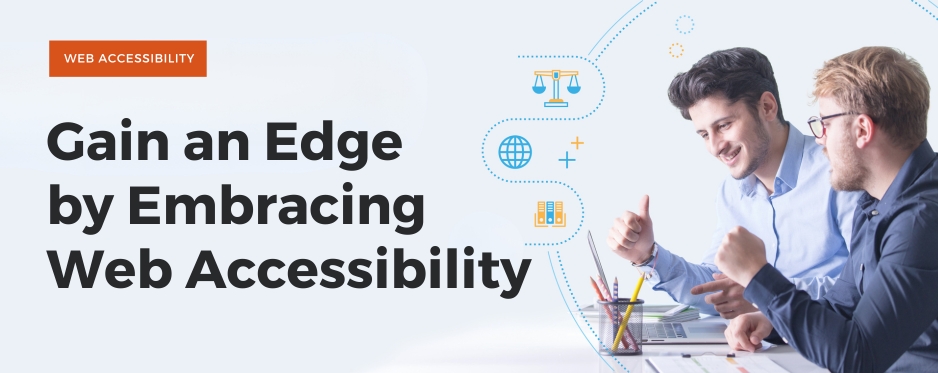
How Web Accessibility Helps St. Louis Businesses Gain an Edge
Worldwide, about 1 billion people live with some form of disability — and in the United States alone, people with disabilities control nearly half a trillion dollars in disposable income.
Needless to say, that’s an enormous market. If your website fails to meet the basic benchmarks of accessibility, you’re artificially limiting your audience.
You’re also taking an unnecessary risk: In 2022, web accessibility lawsuits filed under the Americans with Disabilities Act (ADA) skyrocketed. The Justice Department has confirmed that digital accessibility is required under the ADA, and has proposed new rules that would create clear technical guidelines for compliance.
But while compliance is important, accessibility is fundamentally about the user experience. If your website has low-contrast text, it’s not readable for people with color vision deficiencies. If your mobile app doesn’t play well with keyboards, you’re locking out people who can’t use touchscreens.
For St. Louis businesses, digital accessibility is an opportunity. If you’re thinking about inclusive design for the first time, here’s what you need to know.
Web Accessibility Helps St. Louis Businesses Thrive
Practically, the term “digital accessibility” simply means “good web design.” And fortunately, there’s a rulebook for creating accessible digital content.
 The World Wide Web Consortium (W3C), which publishes standards for HTML, CSS, and other technologies, defines technical standards for accessibility: The Web Content Accessibility Guidelines (WCAG).
The World Wide Web Consortium (W3C), which publishes standards for HTML, CSS, and other technologies, defines technical standards for accessibility: The Web Content Accessibility Guidelines (WCAG).
Most of the requirements in WCAG are simply best practices for design and development. For example, WCAG requires clean code and markup with clear semantics. The guidelines require content to “reflow” when the user’s viewport changes — in other words, websites must have a responsive design.
And while some WCAG requirements are written to address specific accessibility barriers, following the guidelines can improve experiences for everyone:
- Appropriate color contrast makes your text readable for people with color vision deficiencies. High contrast also helps people who read your website in bright ambient light.
- WCAG requires that pointer input targets meet a certain minimum size. That benefits people with mobility disabilities — it also improves the on-page experience for people with small touchscreens.
- Adding captions to videos can make multimedia more useful for Deaf users. Captions also benefit people who choose to browse with their sound turned off — and accurate captions help keep all users engaged.
- Adding alternative text (alt text) to images improves content for folks who use screen readers. Alt text also acts as stand-in content when an image won’t load; when used regularly, alt text can also improve search engine optimization (SEO).
When St. Louis businesses make a commitment to accessible design, they’re also committing to a better user experience (UX). Whether you’re building an eCommerce store or a business-to-business (B2B) sales page, improving your UX helps you reach goal outcomes.
Accessible Design Is An Investment, Not A Cost
There’s a reason that the term “digital accessibility” has become a buzzword in recent years: Over time, accessibility pays off. Your content reaches more people, and your customers have better experiences with your brand.
The business benefits of accessibility can be profound:
- If your website has clean code and markup, it’s generally less expensive to maintain.
- You can add new features without anything “breaking,” and if you decide to migrate to a new platform, you’re well-positioned for a smooth migration.
- People appreciate brands with strong social values. By promoting your accessibility accomplishments, you’re telling your customers that their experiences matter.
- Accessible websites are robust; they work well with different types of technologies, including future technologies that haven’t been invented yet. Imagine having a mobile-ready website in 2007 — that would have been a fairly strong competitive advantage!
St. Louis Businesses: Take The First Steps Towards A More Accessible Website
Blue Stingray is based in St. Louis, and since our inception, we’ve prioritized inclusivity. We believe that an accessible mindset is incredibly valuable — for practical, commercial, and ethical reasons.
If you’re ready to build that mindset, we’re here to help. Whether you’re redesigning a website, creating a new mobile app, or remediating an existing product, our team can help you follow the best practices of inclusive design.
Here are a few tips to help you get started:
- Set a goal. WCAG Level AA is considered the international standard for accessibility (and it’s an excellent goal for improving compliance with the ADA and other laws).
- Test your content. Work with experienced developers who understand WCAG.
- Publish an accessibility statement. The statement should include basic info about your current level of accessibility and your testing processes. The City of St. Louis’s accessibility statement, for example, includes the full text of usability tests, along with customization options for users with disabilities.
- Start remediating accessibility issues. Your accessibility partner can help you fix each barrier in a way that improves experiences for all users.
Learn more by reading about our accessibility audit and remediation services — or call 314.266.8097 to speak with an expert.



